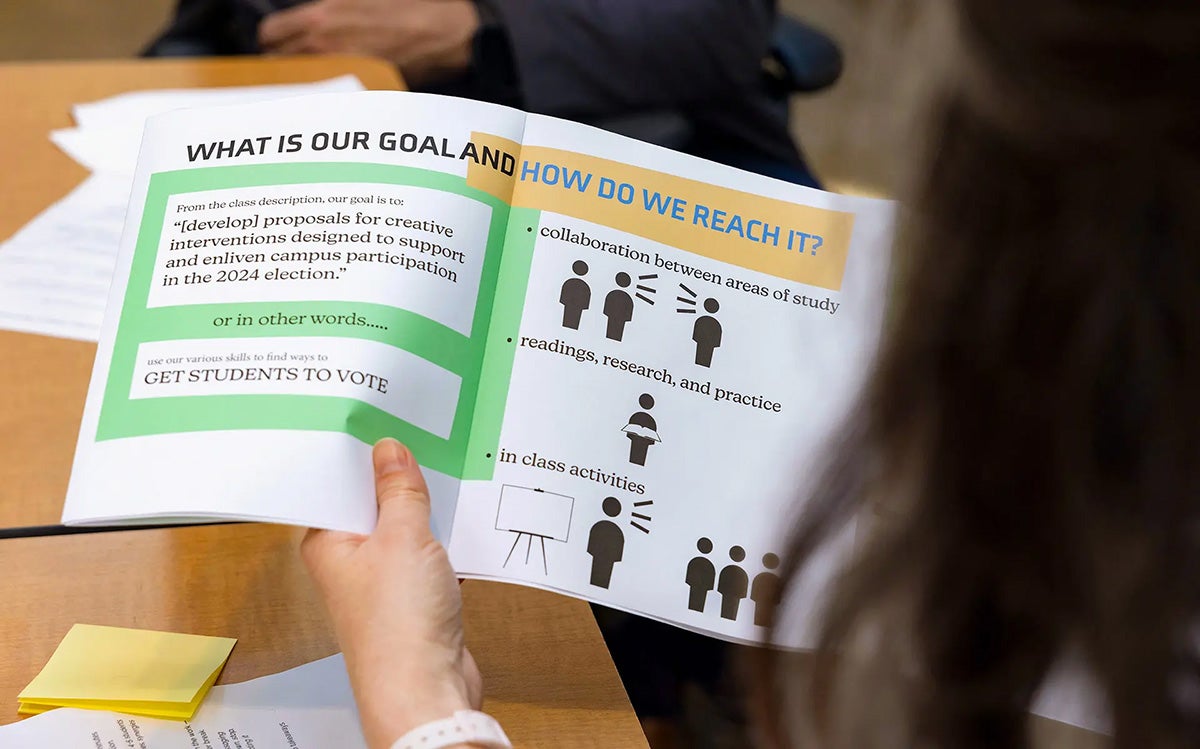This story originally appeared in Maryland Today. Written by Karen Shih ’09, photos by Stephanie S. Cordle.
Nose-deep in the latest TikTok, AirPods jammed into their ears, sunglasses obscuring their eyes—many students don’t take in the world around them as they rush from class to class.
But could a giant Testudo shell packed with games capture their attention? Or mysterious stacked black boxes? Or a multistory projection onto a building’s entrance pillars?
Those are among the many ideas from students in a new University of Maryland class this spring, “Design and Democracy,” which brings together architecture, public policy, government and politics, and art majors to develop pop-up proposals to encourage more college students to register and vote this presidential election year.
Research shows that “the act of voting often leads students to be more interested in gaining civic knowledge and participating in their communities,” said Arts for All Designer-in-Residence Hannah Smotrich, an associate professor of design at the University of Michigan, who is co-teaching the class with UMD architecture Professor Ronit Eisenbach. The course was inspired by the Creative Campus Voting Project at Michigan, co-led by Smotrich, and the Eisenbach-led creative placemaking minor, and is part of UMD’s Arts for All initiative.
 During the first half of the semester, students learned from experts like Ben Hovland, chair of the U.S. Election Assistance Commission, and Naomi Cohen ’15, coordinator for social action and democratic engagement at Stamp who advises TerpsVote, about the importance of civic engagement and the challenges of increasing participation among young people. Americans 18-24 turned out to vote at the lowest rate of any age group in the 2020 election, according to the U.S. census.
During the first half of the semester, students learned from experts like Ben Hovland, chair of the U.S. Election Assistance Commission, and Naomi Cohen ’15, coordinator for social action and democratic engagement at Stamp who advises TerpsVote, about the importance of civic engagement and the challenges of increasing participation among young people. Americans 18-24 turned out to vote at the lowest rate of any age group in the 2020 election, according to the U.S. census.
“How do we get students to not only see that voting is important, but help them figure out how to actually vote?” Eisenbach said. “Our goal is for students to understand the important role that art and design can play in this effort.”
Since STEM majors are less likely to cast a ballot, according to the National Study of Learning, Voting and Engagement, the class focused on ideas to engage engineers, and toured the Jeong H. Kim, A. James Clark and Glenn L. Martin buildings—campus hubs for that discipline—to better understand how students use those spaces.
Then, they developed ideas for installations that could attract people to learn more about voting, informational pamphlets and posters on the registration process, as well as survey questions to understand why students don’t vote.
“When I was younger, I felt more hopeful,” said architecture major Christian Miller ’24 during a class discussion. He shared his nostalgia-based pop-up idea—complete with a Lego model—featuring old-school voting machines, which he hoped would intrigue engineers, and campaign memorabilia from previous elections, which could spur students to ask parents and grandparents about their own early voting memories.

Family was what drew government and politics major Briana McGregor ’26 to the class, she said. She grew up in a “politics-heavy household” where “at Christmas, everyone is yelling about who should be the next president. … So when I meet someone who doesn’t care, it makes me wonder: Why?”
Across the room, immersive media design major and creative placemaking minor Danika Perez ’25 presented her registration poster. “I don’t even know much myself about how to vote,” she admitted, so teaching others about registering at home or on campus was eye-opening.
Bringing students with such different skill sets together has been a challenge, but has also revealed unexpected commonalities between them. “There’s a lot of design and conceptual thinking that crosses those boundaries and is enriched by the specificity of the method and vantage point that each of them brings,” Smotrich said.
Now, the students are forming six interdisciplinary teams to combine their skills and insights into fully realized proposals. By the end of the semester, they hope to create a small-scale exhibit designed to engage the engineering community and prompt conversation and interest in civic participation as the presidential election approaches.
“Maryland is lucky that there’s an amazing group of people interested in this work of expanding civic participation,” said Smotrich. “If these creative projects can bring more people into the conversation, that’s a win.”
